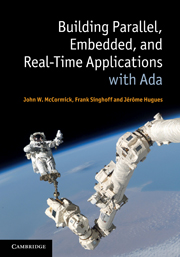Book contents
- Frontmatter
- Contents
- List of illustrations
- List of tables
- Foreword
- Preface
- 1 Introduction and overview
- 2 Sequential programming with Ada
- 3 Task basics
- 4 Communication and synchronization based on shared objects
- 5 Communication and synchronization based on direct interaction
- 6 Distributed systems with Ada
- 7 Real-time systems and scheduling concepts
- 8 Real-time programming with Ada
- 9 Tools for building and verifying real-time applications
- References
- Index
Preface
Published online by Cambridge University Press: 01 June 2011
- Frontmatter
- Contents
- List of illustrations
- List of tables
- Foreword
- Preface
- 1 Introduction and overview
- 2 Sequential programming with Ada
- 3 Task basics
- 4 Communication and synchronization based on shared objects
- 5 Communication and synchronization based on direct interaction
- 6 Distributed systems with Ada
- 7 Real-time systems and scheduling concepts
- 8 Real-time programming with Ada
- 9 Tools for building and verifying real-time applications
- References
- Index
Summary
The arrival and popularity of multi-core processors have sparked a renewed interest in the development of parallel programs. Similarly, the availability of low cost microprocessors and sensors has generated a great interest in embedded real-time programs. This book provides students and programmers with traditional backgrounds in sequential programming the opportunity to expand their capabilities into these important emerging paradigms. It also addresses the theoretical foundations of real-time scheduling analysis, focusing on theory that is useful for real applications.
Two excellent books by Burns and Wellings (2007; 2009) provide a complete, in depth presentation of Ada's concurrent and real-time features. They make use of Ada's powerful object-oriented programming features to create high-level concurrent patterns. These books are “required reading” for software engineers working with Ada on real-time projects. However, we found that their coverage of all of Ada's concurrent and real-time features and the additional level of abstraction provided by their clever use of the object-oriented paradigm made it difficult for our undergraduate students to grasp the fundamental concepts of parallel, embedded, and real-time programming. We believe that the subset of Ada presented in this book provides the simplest model for understanding the fundamental concepts. With this basic knowledge, our readers can more easily learn the more detailed aspects of the Ada language and the more widely applicable patterns presented by Burns and Wellings.
- Type
- Chapter
- Information
- Building Parallel, Embedded, and Real-Time Applications with Ada , pp. xiii - xviiiPublisher: Cambridge University PressPrint publication year: 2011

